Impact of HRM Strategies and Practices on EMNCs Across Borders
VerifiedAdded on 2022/11/12
|11
|2316
|452
Report
AI Summary
This report critically analyzes the cross-border dissemination of HRM strategies and practices by Emerging Market Multinational Corporations (EMNCs). It investigates how cultural and institutional differences in both developed and emerging markets impact the implementation of HRM strategies. The report explores the challenges EMNCs face when transferring HRM practices across borders, including complexities arising from globalization, cultural nuances, and varying regulatory environments. It also examines the adaptive, ethnocentricity and localized approaches EMNCs employ to manage their subsidiaries effectively, highlighting the importance of balancing global standards with local market demands. Through a review of relevant IHRM theoretical and research material, the report provides insights into the factors that contribute to the success or failure of EMNCs in their international operations.
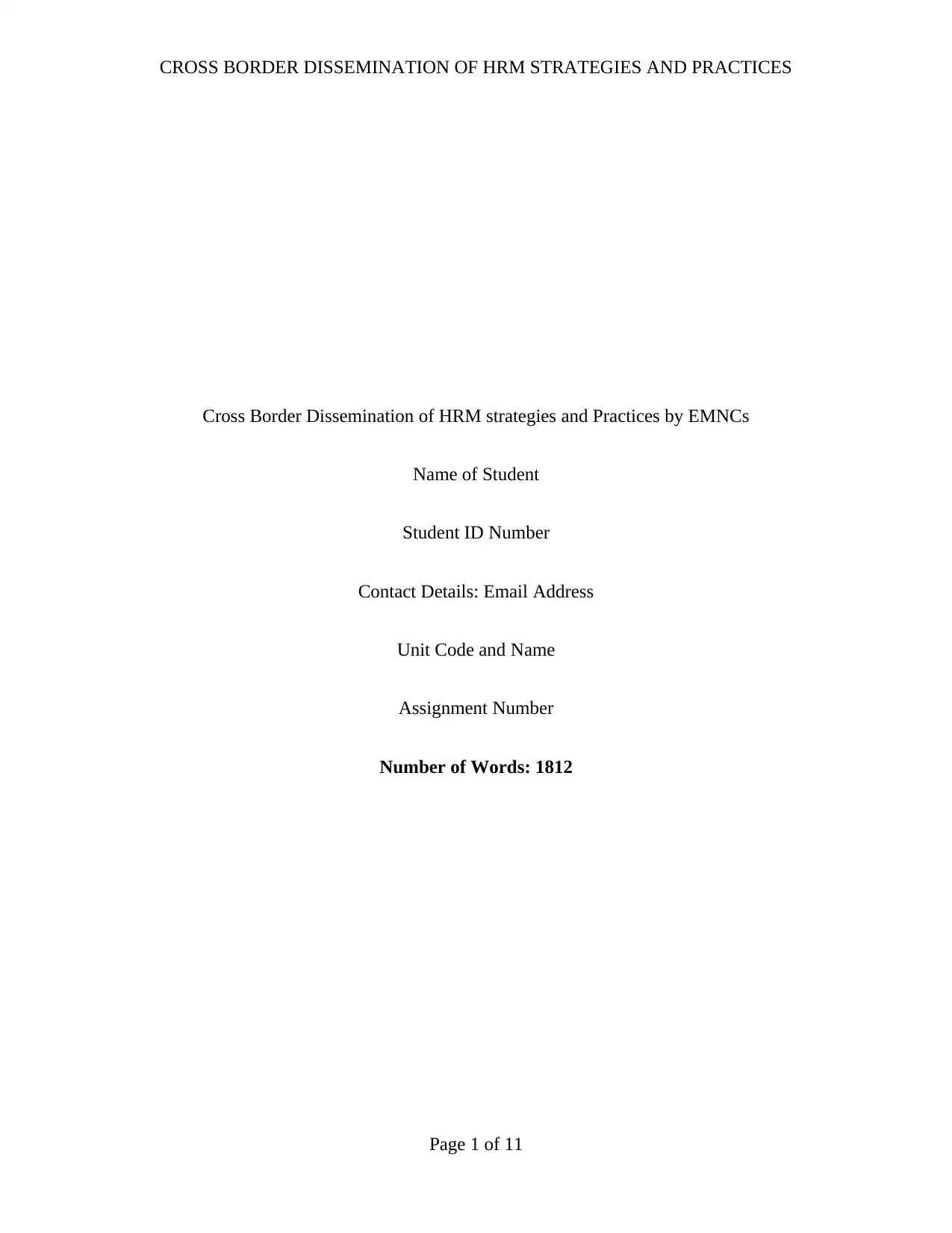
CROSS BORDER DISSEMINATION OF HRM STRATEGIES AND PRACTICES
Cross Border Dissemination of HRM strategies and Practices by EMNCs
Name of Student
Student ID Number
Contact Details: Email Address
Unit Code and Name
Assignment Number
Number of Words: 1812
Page 1 of 11
Cross Border Dissemination of HRM strategies and Practices by EMNCs
Name of Student
Student ID Number
Contact Details: Email Address
Unit Code and Name
Assignment Number
Number of Words: 1812
Page 1 of 11
Paraphrase This Document
Need a fresh take? Get an instant paraphrase of this document with our AI Paraphraser
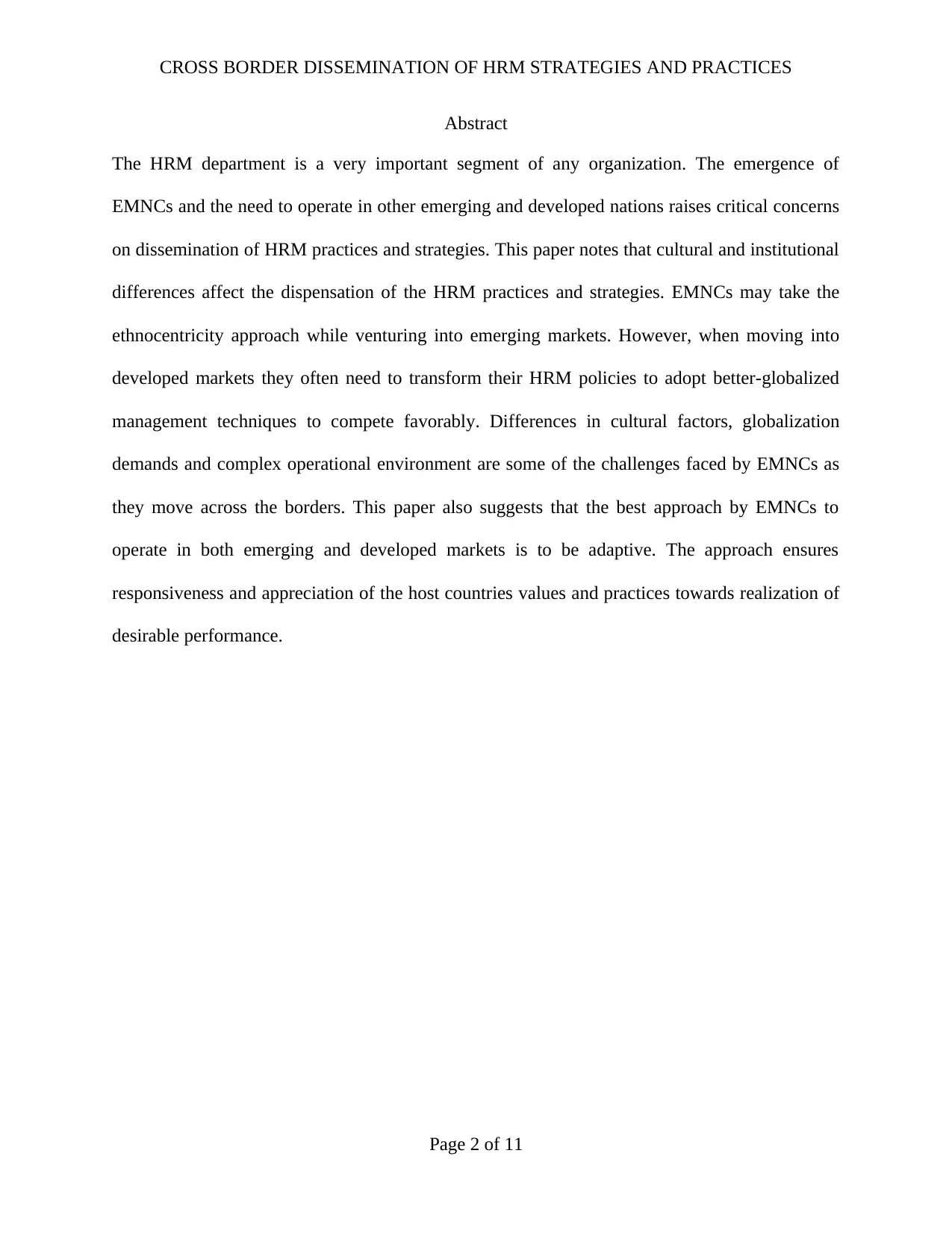
CROSS BORDER DISSEMINATION OF HRM STRATEGIES AND PRACTICES
Abstract
The HRM department is a very important segment of any organization. The emergence of
EMNCs and the need to operate in other emerging and developed nations raises critical concerns
on dissemination of HRM practices and strategies. This paper notes that cultural and institutional
differences affect the dispensation of the HRM practices and strategies. EMNCs may take the
ethnocentricity approach while venturing into emerging markets. However, when moving into
developed markets they often need to transform their HRM policies to adopt better-globalized
management techniques to compete favorably. Differences in cultural factors, globalization
demands and complex operational environment are some of the challenges faced by EMNCs as
they move across the borders. This paper also suggests that the best approach by EMNCs to
operate in both emerging and developed markets is to be adaptive. The approach ensures
responsiveness and appreciation of the host countries values and practices towards realization of
desirable performance.
Page 2 of 11
Abstract
The HRM department is a very important segment of any organization. The emergence of
EMNCs and the need to operate in other emerging and developed nations raises critical concerns
on dissemination of HRM practices and strategies. This paper notes that cultural and institutional
differences affect the dispensation of the HRM practices and strategies. EMNCs may take the
ethnocentricity approach while venturing into emerging markets. However, when moving into
developed markets they often need to transform their HRM policies to adopt better-globalized
management techniques to compete favorably. Differences in cultural factors, globalization
demands and complex operational environment are some of the challenges faced by EMNCs as
they move across the borders. This paper also suggests that the best approach by EMNCs to
operate in both emerging and developed markets is to be adaptive. The approach ensures
responsiveness and appreciation of the host countries values and practices towards realization of
desirable performance.
Page 2 of 11
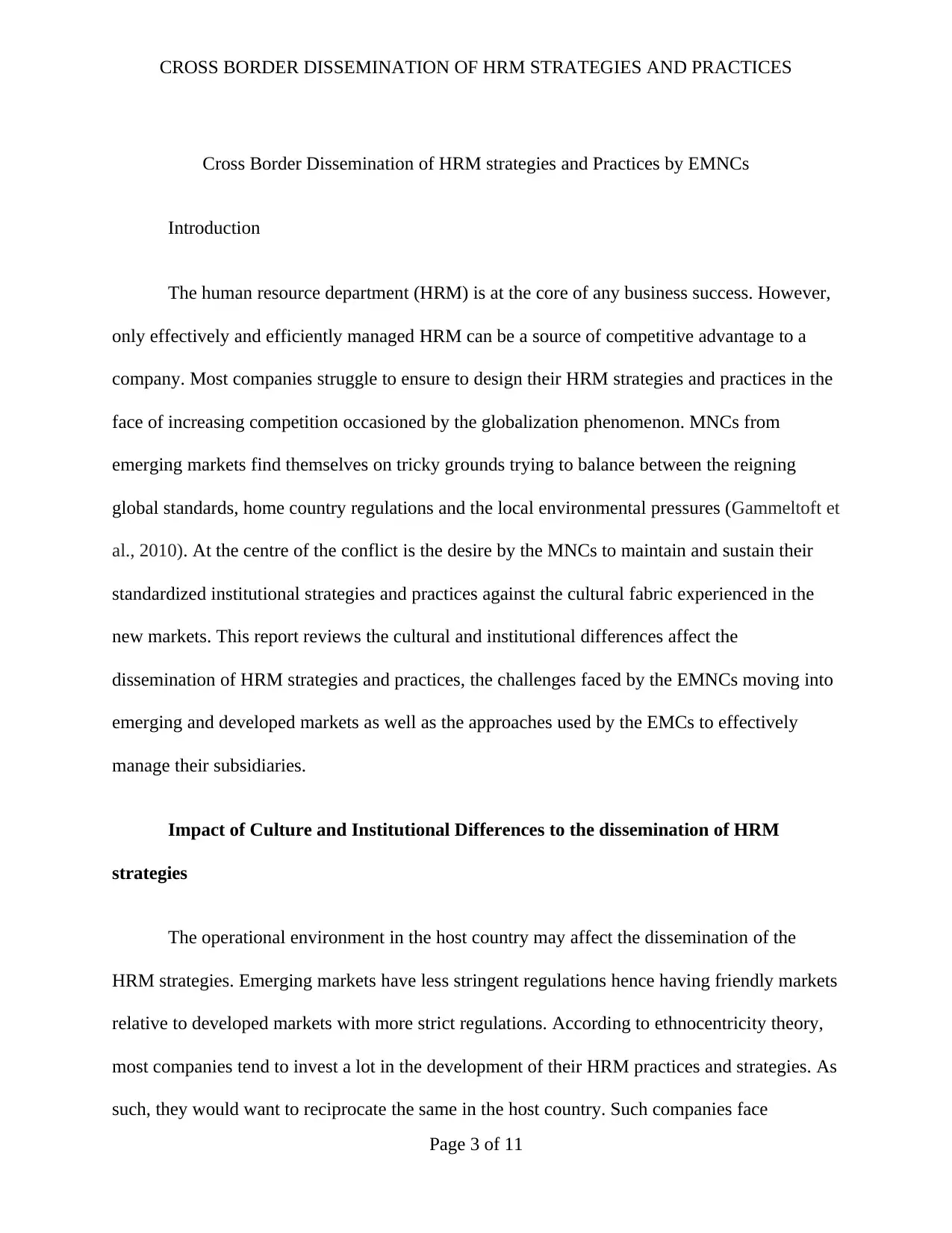
CROSS BORDER DISSEMINATION OF HRM STRATEGIES AND PRACTICES
Cross Border Dissemination of HRM strategies and Practices by EMNCs
Introduction
The human resource department (HRM) is at the core of any business success. However,
only effectively and efficiently managed HRM can be a source of competitive advantage to a
company. Most companies struggle to ensure to design their HRM strategies and practices in the
face of increasing competition occasioned by the globalization phenomenon. MNCs from
emerging markets find themselves on tricky grounds trying to balance between the reigning
global standards, home country regulations and the local environmental pressures (Gammeltoft et
al., 2010). At the centre of the conflict is the desire by the MNCs to maintain and sustain their
standardized institutional strategies and practices against the cultural fabric experienced in the
new markets. This report reviews the cultural and institutional differences affect the
dissemination of HRM strategies and practices, the challenges faced by the EMNCs moving into
emerging and developed markets as well as the approaches used by the EMCs to effectively
manage their subsidiaries.
Impact of Culture and Institutional Differences to the dissemination of HRM
strategies
The operational environment in the host country may affect the dissemination of the
HRM strategies. Emerging markets have less stringent regulations hence having friendly markets
relative to developed markets with more strict regulations. According to ethnocentricity theory,
most companies tend to invest a lot in the development of their HRM practices and strategies. As
such, they would want to reciprocate the same in the host country. Such companies face
Page 3 of 11
Cross Border Dissemination of HRM strategies and Practices by EMNCs
Introduction
The human resource department (HRM) is at the core of any business success. However,
only effectively and efficiently managed HRM can be a source of competitive advantage to a
company. Most companies struggle to ensure to design their HRM strategies and practices in the
face of increasing competition occasioned by the globalization phenomenon. MNCs from
emerging markets find themselves on tricky grounds trying to balance between the reigning
global standards, home country regulations and the local environmental pressures (Gammeltoft et
al., 2010). At the centre of the conflict is the desire by the MNCs to maintain and sustain their
standardized institutional strategies and practices against the cultural fabric experienced in the
new markets. This report reviews the cultural and institutional differences affect the
dissemination of HRM strategies and practices, the challenges faced by the EMNCs moving into
emerging and developed markets as well as the approaches used by the EMCs to effectively
manage their subsidiaries.
Impact of Culture and Institutional Differences to the dissemination of HRM
strategies
The operational environment in the host country may affect the dissemination of the
HRM strategies. Emerging markets have less stringent regulations hence having friendly markets
relative to developed markets with more strict regulations. According to ethnocentricity theory,
most companies tend to invest a lot in the development of their HRM practices and strategies. As
such, they would want to reciprocate the same in the host country. Such companies face
Page 3 of 11
⊘ This is a preview!⊘
Do you want full access?
Subscribe today to unlock all pages.

Trusted by 1+ million students worldwide
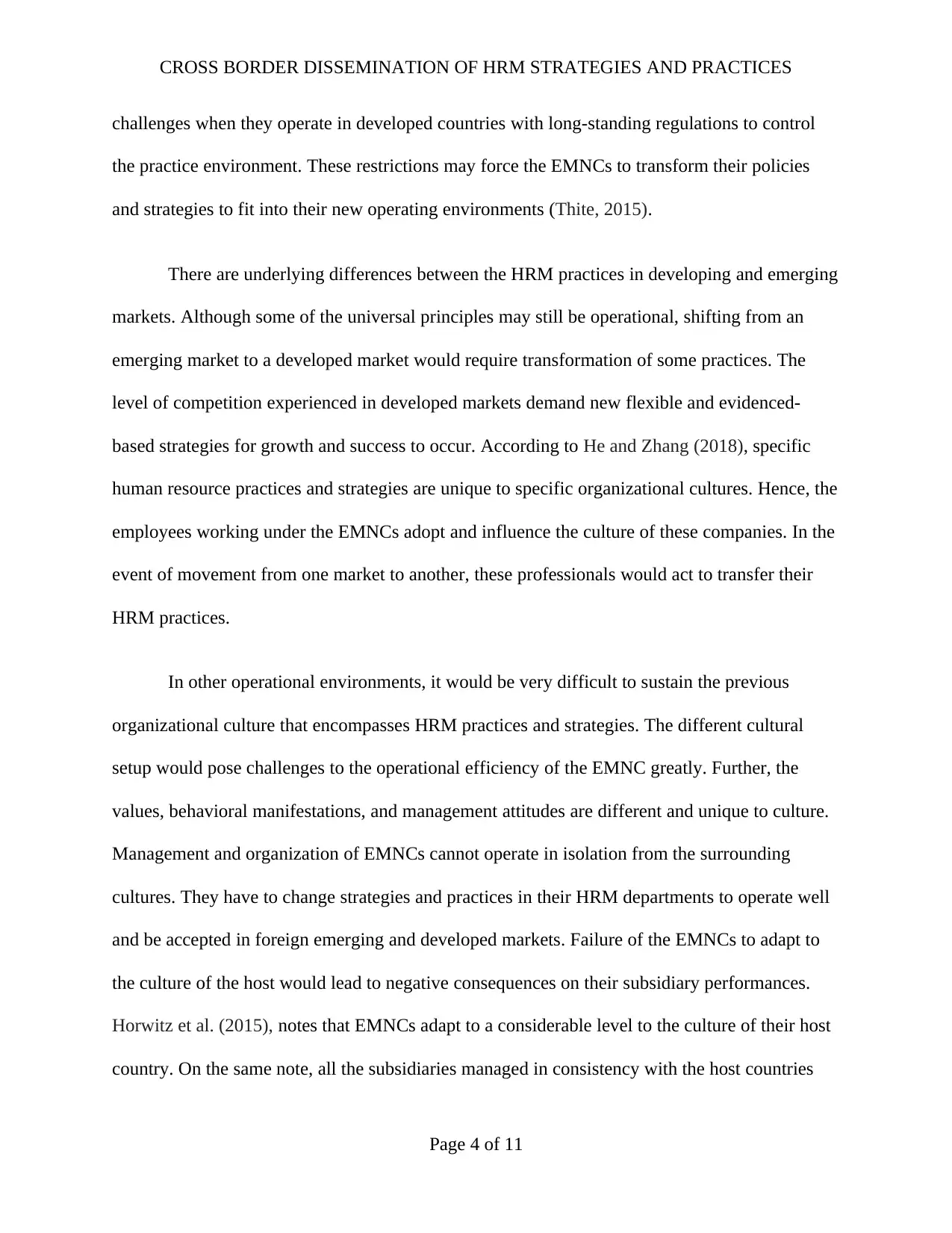
CROSS BORDER DISSEMINATION OF HRM STRATEGIES AND PRACTICES
challenges when they operate in developed countries with long-standing regulations to control
the practice environment. These restrictions may force the EMNCs to transform their policies
and strategies to fit into their new operating environments (Thite, 2015).
There are underlying differences between the HRM practices in developing and emerging
markets. Although some of the universal principles may still be operational, shifting from an
emerging market to a developed market would require transformation of some practices. The
level of competition experienced in developed markets demand new flexible and evidenced-
based strategies for growth and success to occur. According to He and Zhang (2018), specific
human resource practices and strategies are unique to specific organizational cultures. Hence, the
employees working under the EMNCs adopt and influence the culture of these companies. In the
event of movement from one market to another, these professionals would act to transfer their
HRM practices.
In other operational environments, it would be very difficult to sustain the previous
organizational culture that encompasses HRM practices and strategies. The different cultural
setup would pose challenges to the operational efficiency of the EMNC greatly. Further, the
values, behavioral manifestations, and management attitudes are different and unique to culture.
Management and organization of EMNCs cannot operate in isolation from the surrounding
cultures. They have to change strategies and practices in their HRM departments to operate well
and be accepted in foreign emerging and developed markets. Failure of the EMNCs to adapt to
the culture of the host would lead to negative consequences on their subsidiary performances.
Horwitz et al. (2015), notes that EMNCs adapt to a considerable level to the culture of their host
country. On the same note, all the subsidiaries managed in consistency with the host countries
Page 4 of 11
challenges when they operate in developed countries with long-standing regulations to control
the practice environment. These restrictions may force the EMNCs to transform their policies
and strategies to fit into their new operating environments (Thite, 2015).
There are underlying differences between the HRM practices in developing and emerging
markets. Although some of the universal principles may still be operational, shifting from an
emerging market to a developed market would require transformation of some practices. The
level of competition experienced in developed markets demand new flexible and evidenced-
based strategies for growth and success to occur. According to He and Zhang (2018), specific
human resource practices and strategies are unique to specific organizational cultures. Hence, the
employees working under the EMNCs adopt and influence the culture of these companies. In the
event of movement from one market to another, these professionals would act to transfer their
HRM practices.
In other operational environments, it would be very difficult to sustain the previous
organizational culture that encompasses HRM practices and strategies. The different cultural
setup would pose challenges to the operational efficiency of the EMNC greatly. Further, the
values, behavioral manifestations, and management attitudes are different and unique to culture.
Management and organization of EMNCs cannot operate in isolation from the surrounding
cultures. They have to change strategies and practices in their HRM departments to operate well
and be accepted in foreign emerging and developed markets. Failure of the EMNCs to adapt to
the culture of the host would lead to negative consequences on their subsidiary performances.
Horwitz et al. (2015), notes that EMNCs adapt to a considerable level to the culture of their host
country. On the same note, all the subsidiaries managed in consistency with the host countries
Page 4 of 11
Paraphrase This Document
Need a fresh take? Get an instant paraphrase of this document with our AI Paraphraser
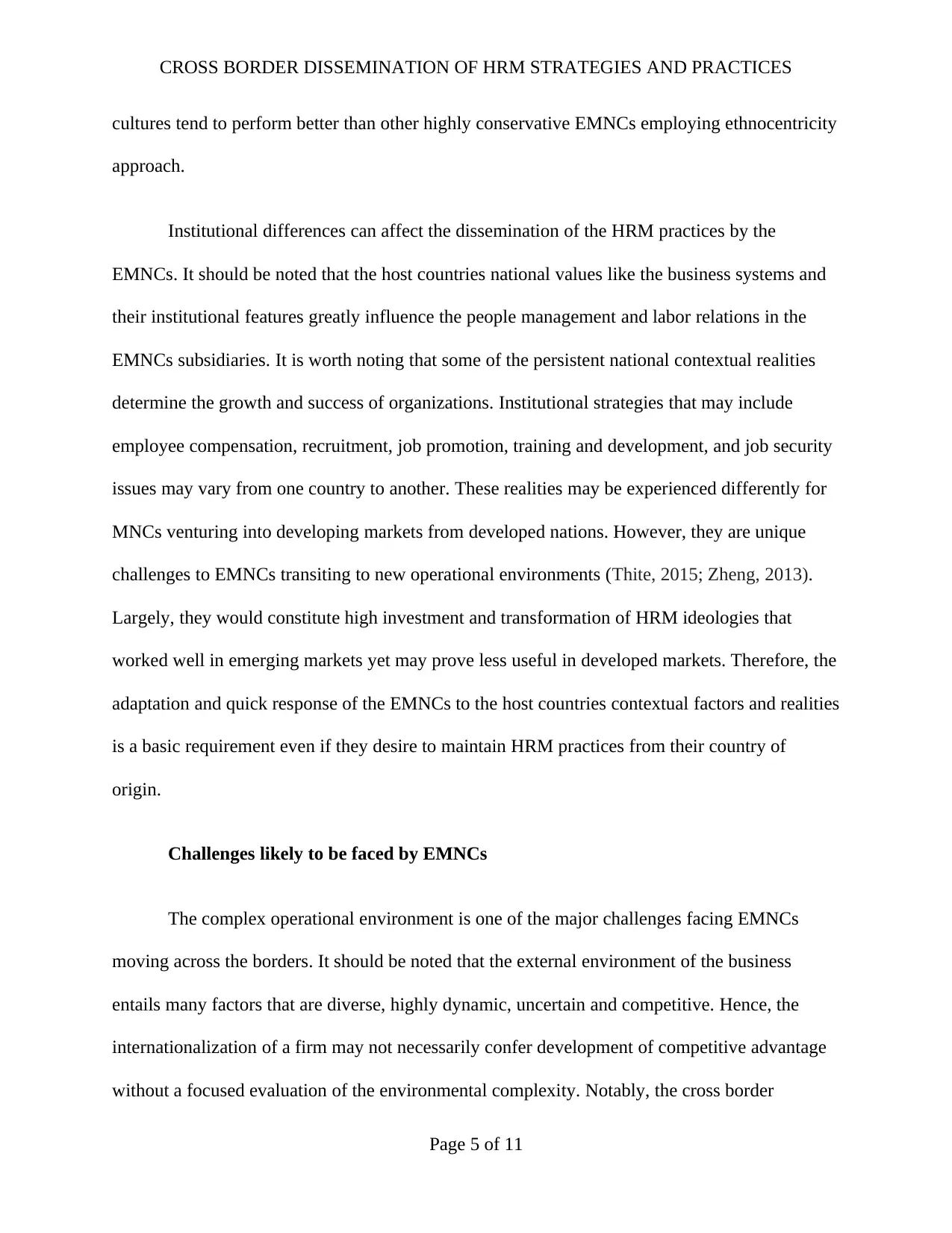
CROSS BORDER DISSEMINATION OF HRM STRATEGIES AND PRACTICES
cultures tend to perform better than other highly conservative EMNCs employing ethnocentricity
approach.
Institutional differences can affect the dissemination of the HRM practices by the
EMNCs. It should be noted that the host countries national values like the business systems and
their institutional features greatly influence the people management and labor relations in the
EMNCs subsidiaries. It is worth noting that some of the persistent national contextual realities
determine the growth and success of organizations. Institutional strategies that may include
employee compensation, recruitment, job promotion, training and development, and job security
issues may vary from one country to another. These realities may be experienced differently for
MNCs venturing into developing markets from developed nations. However, they are unique
challenges to EMNCs transiting to new operational environments (Thite, 2015; Zheng, 2013).
Largely, they would constitute high investment and transformation of HRM ideologies that
worked well in emerging markets yet may prove less useful in developed markets. Therefore, the
adaptation and quick response of the EMNCs to the host countries contextual factors and realities
is a basic requirement even if they desire to maintain HRM practices from their country of
origin.
Challenges likely to be faced by EMNCs
The complex operational environment is one of the major challenges facing EMNCs
moving across the borders. It should be noted that the external environment of the business
entails many factors that are diverse, highly dynamic, uncertain and competitive. Hence, the
internationalization of a firm may not necessarily confer development of competitive advantage
without a focused evaluation of the environmental complexity. Notably, the cross border
Page 5 of 11
cultures tend to perform better than other highly conservative EMNCs employing ethnocentricity
approach.
Institutional differences can affect the dissemination of the HRM practices by the
EMNCs. It should be noted that the host countries national values like the business systems and
their institutional features greatly influence the people management and labor relations in the
EMNCs subsidiaries. It is worth noting that some of the persistent national contextual realities
determine the growth and success of organizations. Institutional strategies that may include
employee compensation, recruitment, job promotion, training and development, and job security
issues may vary from one country to another. These realities may be experienced differently for
MNCs venturing into developing markets from developed nations. However, they are unique
challenges to EMNCs transiting to new operational environments (Thite, 2015; Zheng, 2013).
Largely, they would constitute high investment and transformation of HRM ideologies that
worked well in emerging markets yet may prove less useful in developed markets. Therefore, the
adaptation and quick response of the EMNCs to the host countries contextual factors and realities
is a basic requirement even if they desire to maintain HRM practices from their country of
origin.
Challenges likely to be faced by EMNCs
The complex operational environment is one of the major challenges facing EMNCs
moving across the borders. It should be noted that the external environment of the business
entails many factors that are diverse, highly dynamic, uncertain and competitive. Hence, the
internationalization of a firm may not necessarily confer development of competitive advantage
without a focused evaluation of the environmental complexity. Notably, the cross border
Page 5 of 11
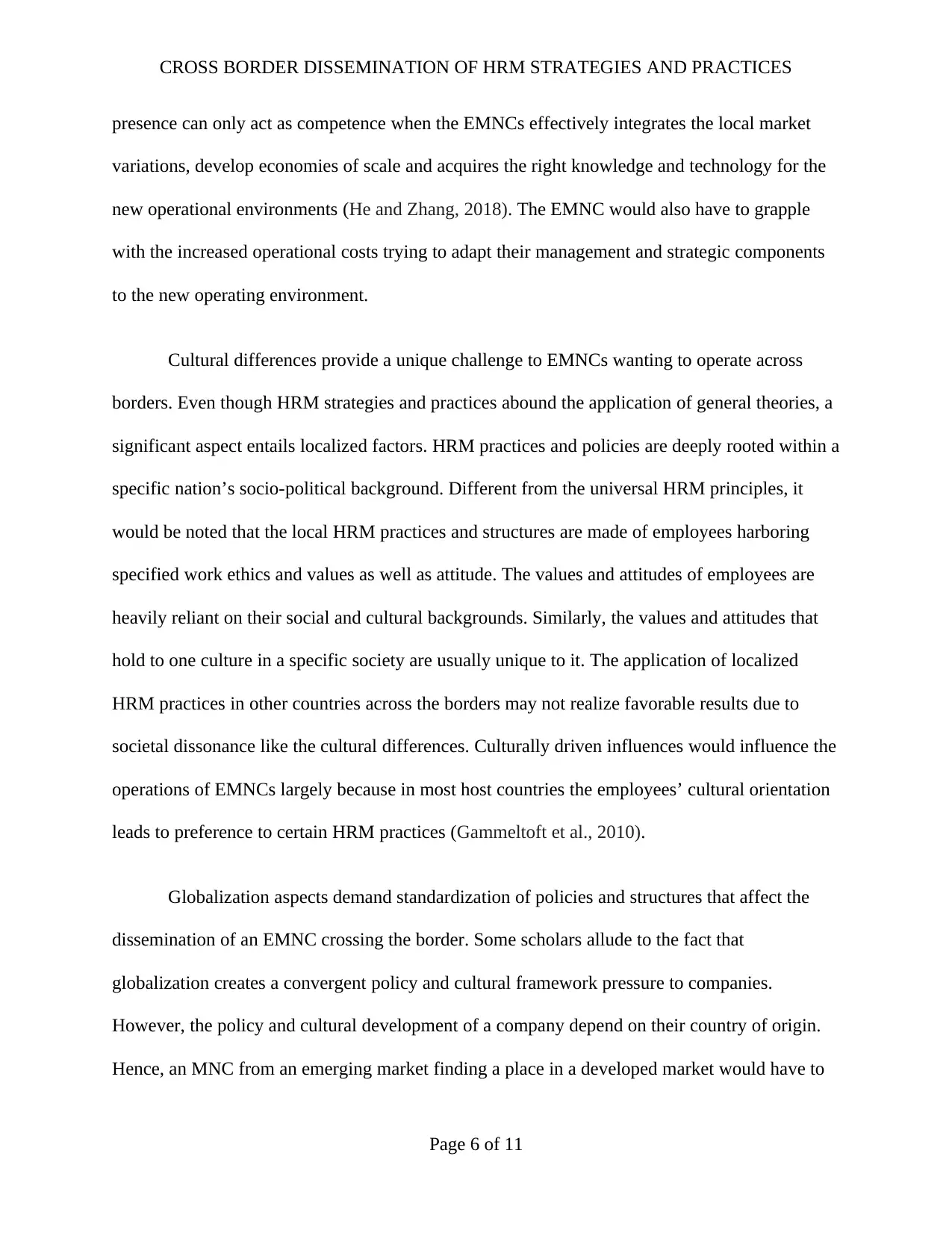
CROSS BORDER DISSEMINATION OF HRM STRATEGIES AND PRACTICES
presence can only act as competence when the EMNCs effectively integrates the local market
variations, develop economies of scale and acquires the right knowledge and technology for the
new operational environments (He and Zhang, 2018). The EMNC would also have to grapple
with the increased operational costs trying to adapt their management and strategic components
to the new operating environment.
Cultural differences provide a unique challenge to EMNCs wanting to operate across
borders. Even though HRM strategies and practices abound the application of general theories, a
significant aspect entails localized factors. HRM practices and policies are deeply rooted within a
specific nation’s socio-political background. Different from the universal HRM principles, it
would be noted that the local HRM practices and structures are made of employees harboring
specified work ethics and values as well as attitude. The values and attitudes of employees are
heavily reliant on their social and cultural backgrounds. Similarly, the values and attitudes that
hold to one culture in a specific society are usually unique to it. The application of localized
HRM practices in other countries across the borders may not realize favorable results due to
societal dissonance like the cultural differences. Culturally driven influences would influence the
operations of EMNCs largely because in most host countries the employees’ cultural orientation
leads to preference to certain HRM practices (Gammeltoft et al., 2010).
Globalization aspects demand standardization of policies and structures that affect the
dissemination of an EMNC crossing the border. Some scholars allude to the fact that
globalization creates a convergent policy and cultural framework pressure to companies.
However, the policy and cultural development of a company depend on their country of origin.
Hence, an MNC from an emerging market finding a place in a developed market would have to
Page 6 of 11
presence can only act as competence when the EMNCs effectively integrates the local market
variations, develop economies of scale and acquires the right knowledge and technology for the
new operational environments (He and Zhang, 2018). The EMNC would also have to grapple
with the increased operational costs trying to adapt their management and strategic components
to the new operating environment.
Cultural differences provide a unique challenge to EMNCs wanting to operate across
borders. Even though HRM strategies and practices abound the application of general theories, a
significant aspect entails localized factors. HRM practices and policies are deeply rooted within a
specific nation’s socio-political background. Different from the universal HRM principles, it
would be noted that the local HRM practices and structures are made of employees harboring
specified work ethics and values as well as attitude. The values and attitudes of employees are
heavily reliant on their social and cultural backgrounds. Similarly, the values and attitudes that
hold to one culture in a specific society are usually unique to it. The application of localized
HRM practices in other countries across the borders may not realize favorable results due to
societal dissonance like the cultural differences. Culturally driven influences would influence the
operations of EMNCs largely because in most host countries the employees’ cultural orientation
leads to preference to certain HRM practices (Gammeltoft et al., 2010).
Globalization aspects demand standardization of policies and structures that affect the
dissemination of an EMNC crossing the border. Some scholars allude to the fact that
globalization creates a convergent policy and cultural framework pressure to companies.
However, the policy and cultural development of a company depend on their country of origin.
Hence, an MNC from an emerging market finding a place in a developed market would have to
Page 6 of 11
⊘ This is a preview!⊘
Do you want full access?
Subscribe today to unlock all pages.

Trusted by 1+ million students worldwide
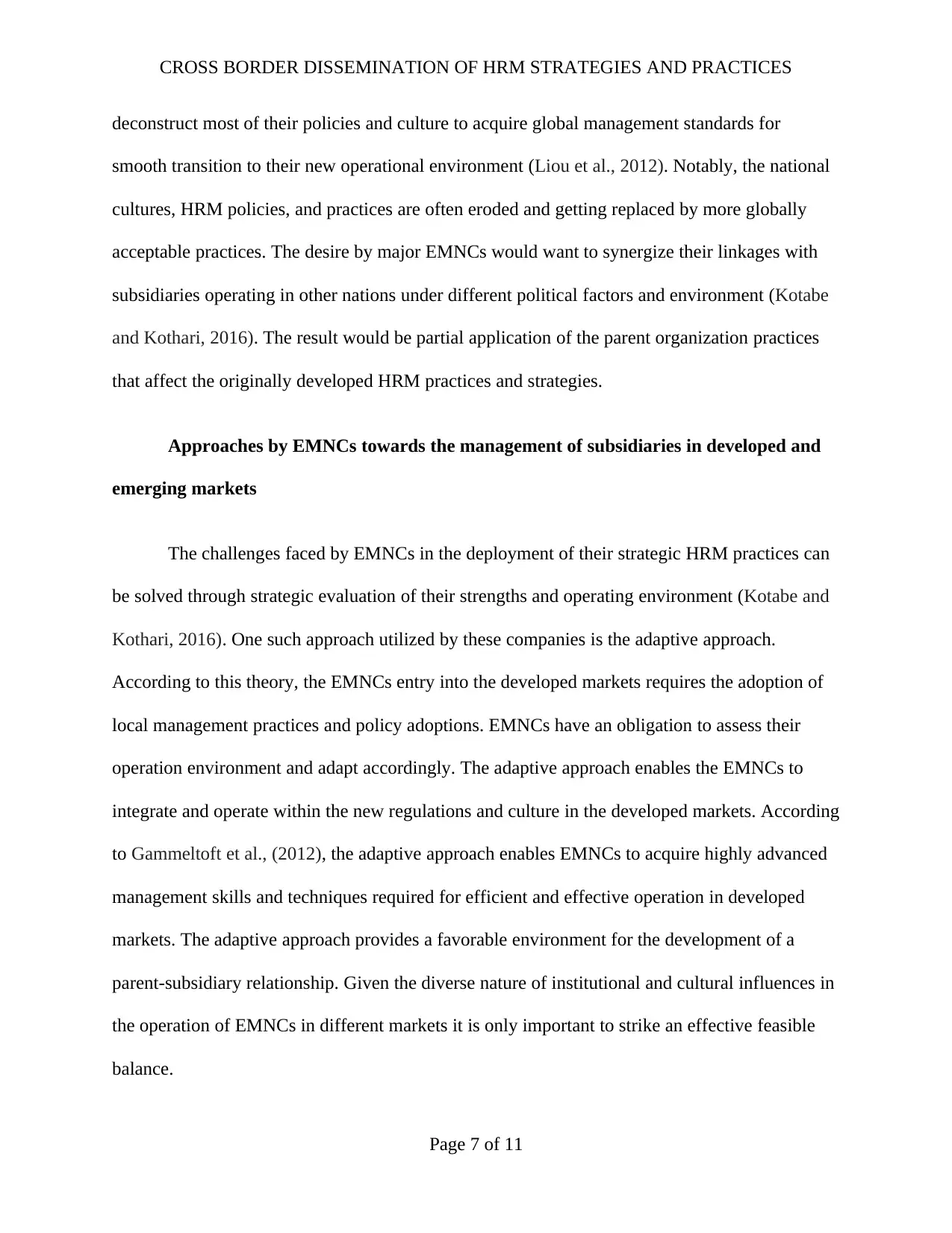
CROSS BORDER DISSEMINATION OF HRM STRATEGIES AND PRACTICES
deconstruct most of their policies and culture to acquire global management standards for
smooth transition to their new operational environment (Liou et al., 2012). Notably, the national
cultures, HRM policies, and practices are often eroded and getting replaced by more globally
acceptable practices. The desire by major EMNCs would want to synergize their linkages with
subsidiaries operating in other nations under different political factors and environment (Kotabe
and Kothari, 2016). The result would be partial application of the parent organization practices
that affect the originally developed HRM practices and strategies.
Approaches by EMNCs towards the management of subsidiaries in developed and
emerging markets
The challenges faced by EMNCs in the deployment of their strategic HRM practices can
be solved through strategic evaluation of their strengths and operating environment (Kotabe and
Kothari, 2016). One such approach utilized by these companies is the adaptive approach.
According to this theory, the EMNCs entry into the developed markets requires the adoption of
local management practices and policy adoptions. EMNCs have an obligation to assess their
operation environment and adapt accordingly. The adaptive approach enables the EMNCs to
integrate and operate within the new regulations and culture in the developed markets. According
to Gammeltoft et al., (2012), the adaptive approach enables EMNCs to acquire highly advanced
management skills and techniques required for efficient and effective operation in developed
markets. The adaptive approach provides a favorable environment for the development of a
parent-subsidiary relationship. Given the diverse nature of institutional and cultural influences in
the operation of EMNCs in different markets it is only important to strike an effective feasible
balance.
Page 7 of 11
deconstruct most of their policies and culture to acquire global management standards for
smooth transition to their new operational environment (Liou et al., 2012). Notably, the national
cultures, HRM policies, and practices are often eroded and getting replaced by more globally
acceptable practices. The desire by major EMNCs would want to synergize their linkages with
subsidiaries operating in other nations under different political factors and environment (Kotabe
and Kothari, 2016). The result would be partial application of the parent organization practices
that affect the originally developed HRM practices and strategies.
Approaches by EMNCs towards the management of subsidiaries in developed and
emerging markets
The challenges faced by EMNCs in the deployment of their strategic HRM practices can
be solved through strategic evaluation of their strengths and operating environment (Kotabe and
Kothari, 2016). One such approach utilized by these companies is the adaptive approach.
According to this theory, the EMNCs entry into the developed markets requires the adoption of
local management practices and policy adoptions. EMNCs have an obligation to assess their
operation environment and adapt accordingly. The adaptive approach enables the EMNCs to
integrate and operate within the new regulations and culture in the developed markets. According
to Gammeltoft et al., (2012), the adaptive approach enables EMNCs to acquire highly advanced
management skills and techniques required for efficient and effective operation in developed
markets. The adaptive approach provides a favorable environment for the development of a
parent-subsidiary relationship. Given the diverse nature of institutional and cultural influences in
the operation of EMNCs in different markets it is only important to strike an effective feasible
balance.
Page 7 of 11
Paraphrase This Document
Need a fresh take? Get an instant paraphrase of this document with our AI Paraphraser
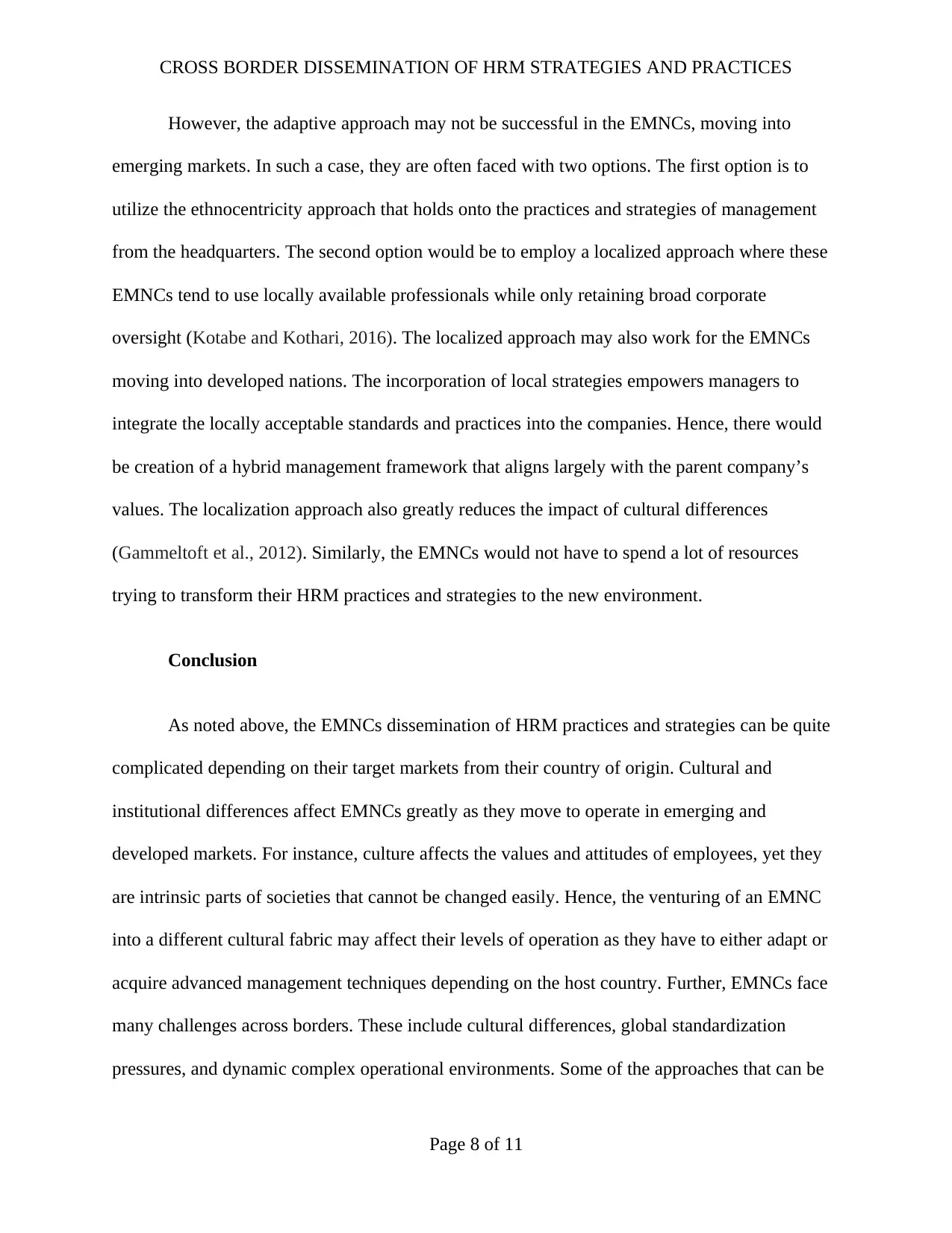
CROSS BORDER DISSEMINATION OF HRM STRATEGIES AND PRACTICES
However, the adaptive approach may not be successful in the EMNCs, moving into
emerging markets. In such a case, they are often faced with two options. The first option is to
utilize the ethnocentricity approach that holds onto the practices and strategies of management
from the headquarters. The second option would be to employ a localized approach where these
EMNCs tend to use locally available professionals while only retaining broad corporate
oversight (Kotabe and Kothari, 2016). The localized approach may also work for the EMNCs
moving into developed nations. The incorporation of local strategies empowers managers to
integrate the locally acceptable standards and practices into the companies. Hence, there would
be creation of a hybrid management framework that aligns largely with the parent company’s
values. The localization approach also greatly reduces the impact of cultural differences
(Gammeltoft et al., 2012). Similarly, the EMNCs would not have to spend a lot of resources
trying to transform their HRM practices and strategies to the new environment.
Conclusion
As noted above, the EMNCs dissemination of HRM practices and strategies can be quite
complicated depending on their target markets from their country of origin. Cultural and
institutional differences affect EMNCs greatly as they move to operate in emerging and
developed markets. For instance, culture affects the values and attitudes of employees, yet they
are intrinsic parts of societies that cannot be changed easily. Hence, the venturing of an EMNC
into a different cultural fabric may affect their levels of operation as they have to either adapt or
acquire advanced management techniques depending on the host country. Further, EMNCs face
many challenges across borders. These include cultural differences, global standardization
pressures, and dynamic complex operational environments. Some of the approaches that can be
Page 8 of 11
However, the adaptive approach may not be successful in the EMNCs, moving into
emerging markets. In such a case, they are often faced with two options. The first option is to
utilize the ethnocentricity approach that holds onto the practices and strategies of management
from the headquarters. The second option would be to employ a localized approach where these
EMNCs tend to use locally available professionals while only retaining broad corporate
oversight (Kotabe and Kothari, 2016). The localized approach may also work for the EMNCs
moving into developed nations. The incorporation of local strategies empowers managers to
integrate the locally acceptable standards and practices into the companies. Hence, there would
be creation of a hybrid management framework that aligns largely with the parent company’s
values. The localization approach also greatly reduces the impact of cultural differences
(Gammeltoft et al., 2012). Similarly, the EMNCs would not have to spend a lot of resources
trying to transform their HRM practices and strategies to the new environment.
Conclusion
As noted above, the EMNCs dissemination of HRM practices and strategies can be quite
complicated depending on their target markets from their country of origin. Cultural and
institutional differences affect EMNCs greatly as they move to operate in emerging and
developed markets. For instance, culture affects the values and attitudes of employees, yet they
are intrinsic parts of societies that cannot be changed easily. Hence, the venturing of an EMNC
into a different cultural fabric may affect their levels of operation as they have to either adapt or
acquire advanced management techniques depending on the host country. Further, EMNCs face
many challenges across borders. These include cultural differences, global standardization
pressures, and dynamic complex operational environments. Some of the approaches that can be
Page 8 of 11
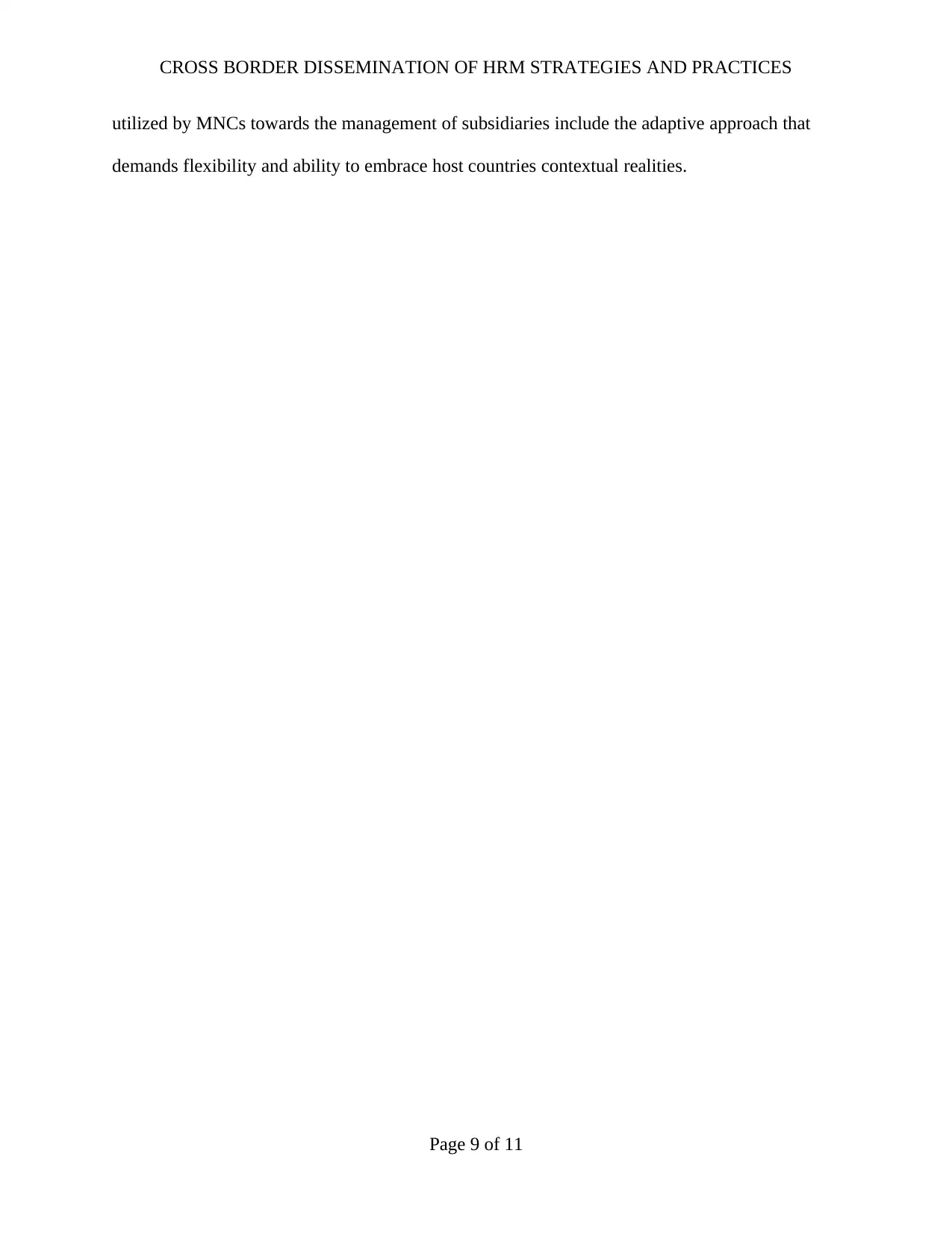
CROSS BORDER DISSEMINATION OF HRM STRATEGIES AND PRACTICES
utilized by MNCs towards the management of subsidiaries include the adaptive approach that
demands flexibility and ability to embrace host countries contextual realities.
Page 9 of 11
utilized by MNCs towards the management of subsidiaries include the adaptive approach that
demands flexibility and ability to embrace host countries contextual realities.
Page 9 of 11
⊘ This is a preview!⊘
Do you want full access?
Subscribe today to unlock all pages.

Trusted by 1+ million students worldwide
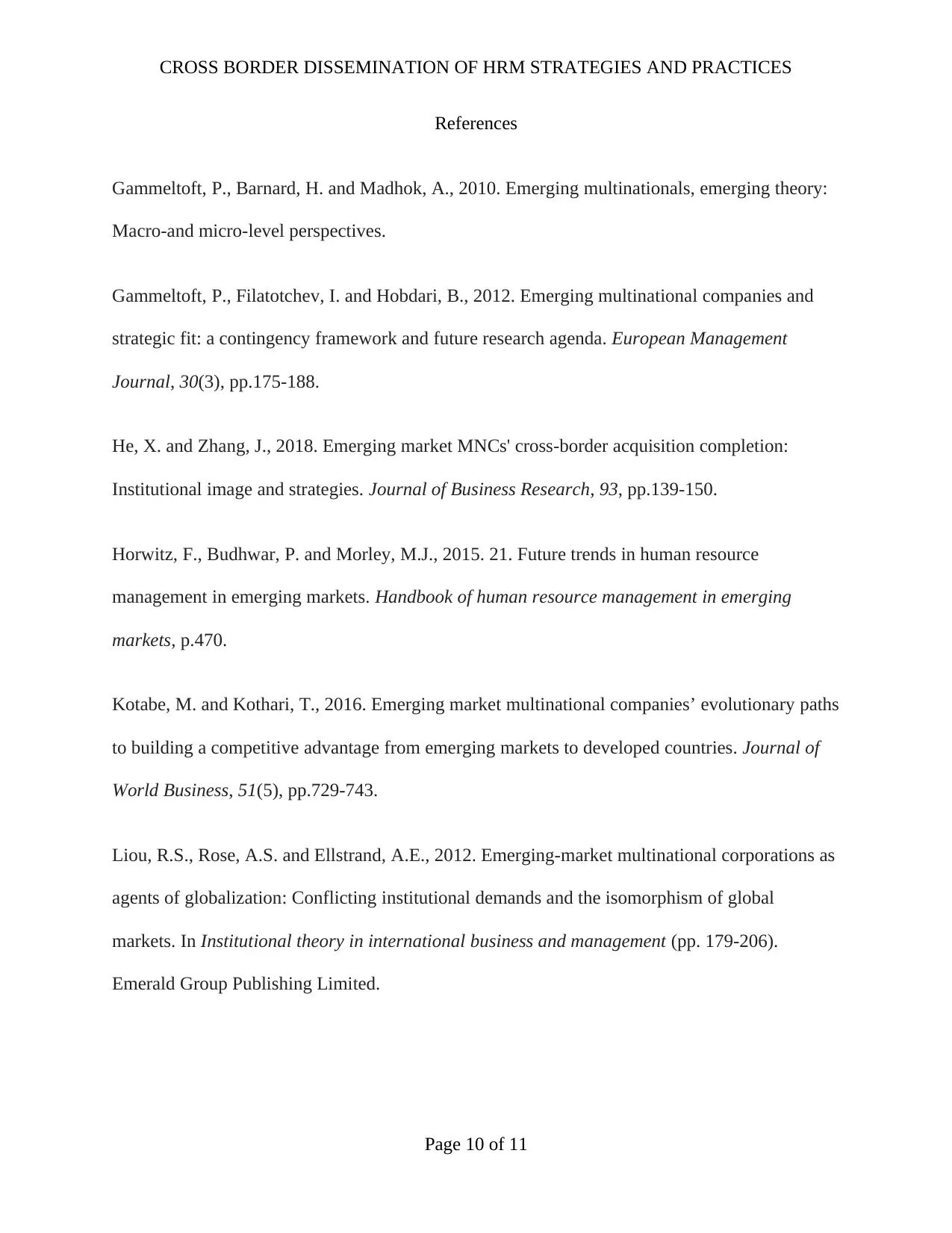
CROSS BORDER DISSEMINATION OF HRM STRATEGIES AND PRACTICES
References
Gammeltoft, P., Barnard, H. and Madhok, A., 2010. Emerging multinationals, emerging theory:
Macro-and micro-level perspectives.
Gammeltoft, P., Filatotchev, I. and Hobdari, B., 2012. Emerging multinational companies and
strategic fit: a contingency framework and future research agenda. European Management
Journal, 30(3), pp.175-188.
He, X. and Zhang, J., 2018. Emerging market MNCs' cross-border acquisition completion:
Institutional image and strategies. Journal of Business Research, 93, pp.139-150.
Horwitz, F., Budhwar, P. and Morley, M.J., 2015. 21. Future trends in human resource
management in emerging markets. Handbook of human resource management in emerging
markets, p.470.
Kotabe, M. and Kothari, T., 2016. Emerging market multinational companies’ evolutionary paths
to building a competitive advantage from emerging markets to developed countries. Journal of
World Business, 51(5), pp.729-743.
Liou, R.S., Rose, A.S. and Ellstrand, A.E., 2012. Emerging-market multinational corporations as
agents of globalization: Conflicting institutional demands and the isomorphism of global
markets. In Institutional theory in international business and management (pp. 179-206).
Emerald Group Publishing Limited.
Page 10 of 11
References
Gammeltoft, P., Barnard, H. and Madhok, A., 2010. Emerging multinationals, emerging theory:
Macro-and micro-level perspectives.
Gammeltoft, P., Filatotchev, I. and Hobdari, B., 2012. Emerging multinational companies and
strategic fit: a contingency framework and future research agenda. European Management
Journal, 30(3), pp.175-188.
He, X. and Zhang, J., 2018. Emerging market MNCs' cross-border acquisition completion:
Institutional image and strategies. Journal of Business Research, 93, pp.139-150.
Horwitz, F., Budhwar, P. and Morley, M.J., 2015. 21. Future trends in human resource
management in emerging markets. Handbook of human resource management in emerging
markets, p.470.
Kotabe, M. and Kothari, T., 2016. Emerging market multinational companies’ evolutionary paths
to building a competitive advantage from emerging markets to developed countries. Journal of
World Business, 51(5), pp.729-743.
Liou, R.S., Rose, A.S. and Ellstrand, A.E., 2012. Emerging-market multinational corporations as
agents of globalization: Conflicting institutional demands and the isomorphism of global
markets. In Institutional theory in international business and management (pp. 179-206).
Emerald Group Publishing Limited.
Page 10 of 11
Paraphrase This Document
Need a fresh take? Get an instant paraphrase of this document with our AI Paraphraser
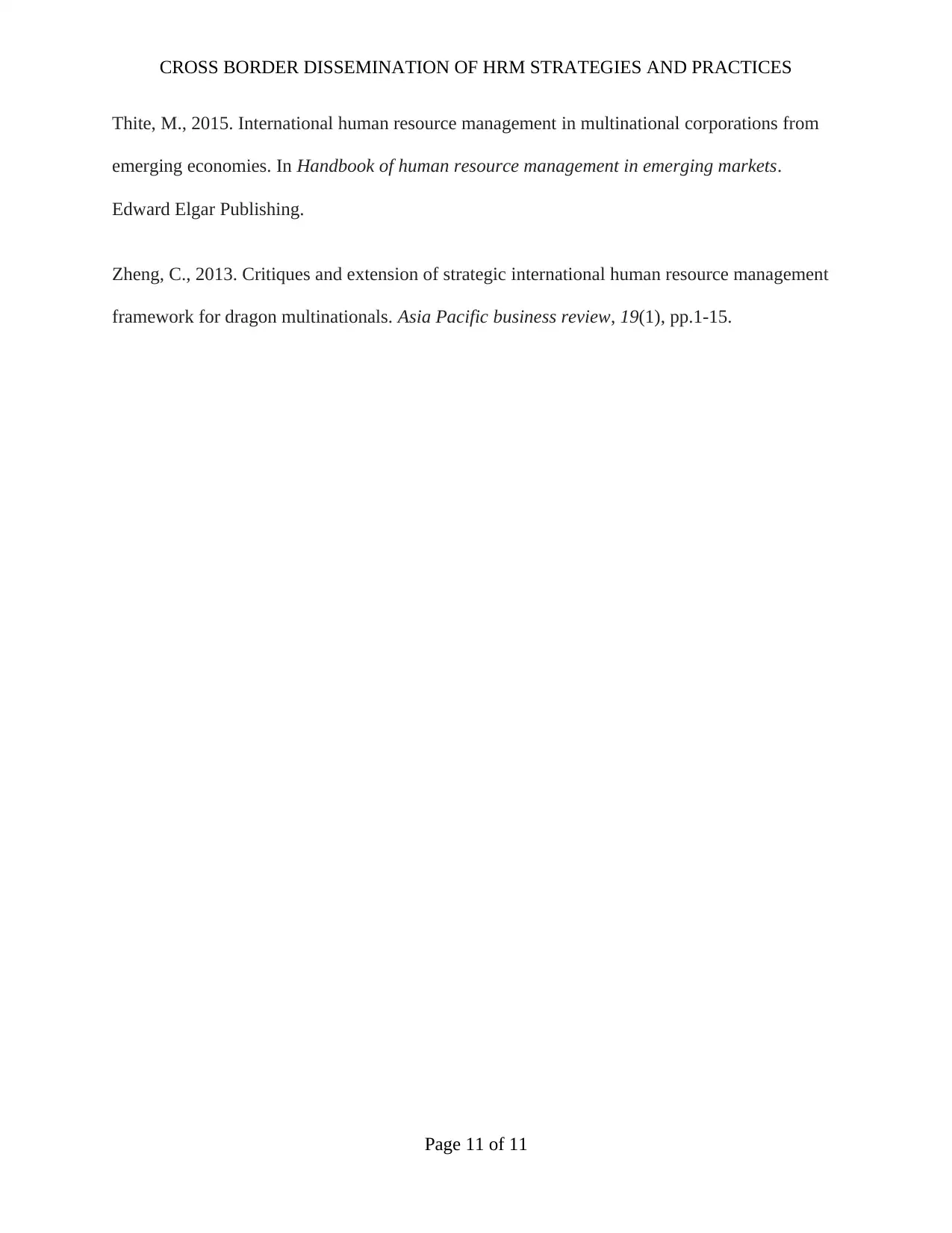
CROSS BORDER DISSEMINATION OF HRM STRATEGIES AND PRACTICES
Thite, M., 2015. International human resource management in multinational corporations from
emerging economies. In Handbook of human resource management in emerging markets.
Edward Elgar Publishing.
Zheng, C., 2013. Critiques and extension of strategic international human resource management
framework for dragon multinationals. Asia Pacific business review, 19(1), pp.1-15.
Page 11 of 11
Thite, M., 2015. International human resource management in multinational corporations from
emerging economies. In Handbook of human resource management in emerging markets.
Edward Elgar Publishing.
Zheng, C., 2013. Critiques and extension of strategic international human resource management
framework for dragon multinationals. Asia Pacific business review, 19(1), pp.1-15.
Page 11 of 11
1 out of 11
Related Documents
Your All-in-One AI-Powered Toolkit for Academic Success.
+13062052269
info@desklib.com
Available 24*7 on WhatsApp / Email
![[object Object]](/_next/static/media/star-bottom.7253800d.svg)
Unlock your academic potential
Copyright © 2020–2025 A2Z Services. All Rights Reserved. Developed and managed by ZUCOL.





